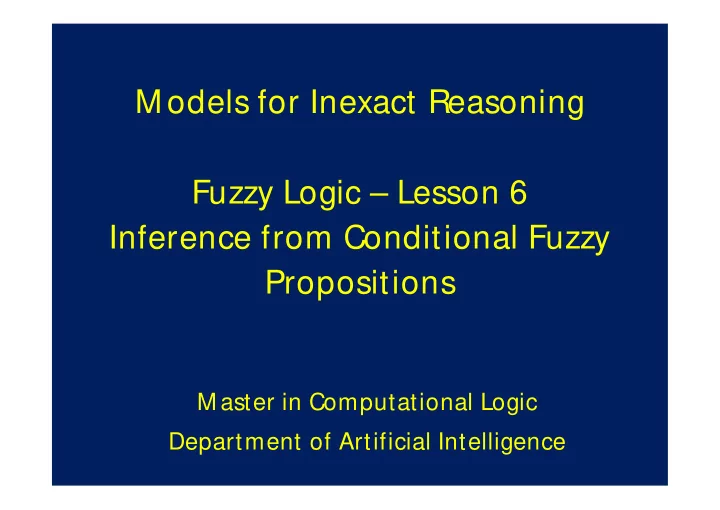

M odels for Inexact Reasoning Fuzzy Logic – Lesson 6 Inference from Conditional Fuzzy Propositions M aster in Computational Logic Department of Artificial Intelligence
Inference in Classical Logic • Inference rules in classical logic are based on tautologies • Three classical inference rules: – M odus Ponendo Ponens (M odus Ponens) • Latin for “ The way that affirms by affirming” – M odus Tollens (M odus Tollendo Tollens) • Latin for “ The way that denies by denying” – Hypothetical Syllogism → → → p q p q p q ¬ → q q r p ¬ → p p r q
Generalization of Inference Rules • Classical inference rules can be generalized in the context of fuzzy logic • Generalized inference rules provide a framework to facilitate approximate reasoning • Generalized versions of M P , M T and HS • Generalization based on: – Fuzzy relations – The compositional rule of inference
The Compositional Rule of Inference • Let R be a crisp relation defined over X × Y • Given a value x=u it is possible to infer that y ∈ B = {y ∈ Y| <u, y> ∈ R} • M oreover, given a set A ⊆ X we can infer that y ∈ B = {y ∈ Y| <x, y> ∈ R, x ∈ A}
The Compositional Rule of Inference • Now assume that R is a fuzzy relation on X × Y • Let A’ be a fuzzy set defined over the elements of the crisp set X • It is possible to infer a fuzzy set B’ defined over the elements of the crisp set Y ( ) µ = µ ( ) y sup min ( ), ( , ) x R x y B ' A ' ∈ x X
The Compositional Rule of Inference • When dealing with discrete sets the CRI can be also expressed in matrix form • Resorting to the definition of the composition of fuzzy relations we have: ( ) ( ) ( ) = B ' A ' o R • A’ is the vector associated to fuzzy set A’ • R is the matrix associated to fuzzy relation R • B’ is the vector associated to the inferred fuzzy set B’
The Generalized M odus Ponens • Let consider the following conditional fuzzy proposition: p : “ If X is A, then Y is B” • Note that a fuzzy relation R is embedded in p – An implication relationship between fuzzy sets A, B = µ µ R x y ( , ) J ( ( ), x ( )) y A B • The operator J( ⋅ , ⋅ ) denotes a fuzzy implication
The Generalized M odus Ponens • Now, we are given a second proposition q: “ X is A’” • Viewing p as a rule and q as a fact we have: • Applying the CRI on R’ and A’ we can conclude that: Rule: If X is A, then Y is B Fact: X is A’ ======================== Conclusion: Y is B’
Example • X = {x 1 , x 2 , x 3 }, Y = {y 1 , y 2 } • A = .5/ x 1 + 1/ x 2 + .6/ x 3 , B = 1/ y 1 + .4/ y 2 • A’ = .6/ x 1 + .9/ x 2 + .7/ x 3 • Use the compositional rule of inference to derive a conclusion in the form “ Y is B’” • Use Lukasiewicz’s implication – J(x, y) = min(1, 1-a+b)
The Generalized M odus Tollens • The generalized modus tollens is expressed as: Rule: If X is A, then Y is B Fact: Y is B’ ============================== Conclusion: X is A’ • In this case, the CRI is expressed as follows: ( ) µ = µ ( ) x sup min ( ), ( , ) y R x y A ' B ' ∈ y Y • Or in matrix form: = A ' B ' o R
Example • X = {x 1 , x 2 , x 3 }, Y = {y 1 , y 2 } • A = .5/ x 1 + 1/ x 2 + .6/ x 3 , B = 1/ y 1 + .4/ y 2 • B’ = .9/ y 1 + .7/ y 2 • Use the compositional rule of inference to derive a conclusion in the form “ X is A’” • Use Lukasiewicz’s implication – J(x, y) = min(1, 1-a+b)
The Generalized Hypothetical Syllogism • The HS can be expressed as follows: Rule 1: If X is A, then Y is B Rule 2: If Y is B, then Z is C ============================== Conclusion: If X is A, then Z is C • In this case, we can say that the HS holds if: ( ) = R x z ( , ) sup min R x y R ( , ), ( , ) y z 3 1 2 ∈ y Y • Or in matrix form: = R R o R 3 1 2
Example • X = {x 1 , x 2 , x 3 }, Y = {y 1 , y 2 }, Z = {z 1 , z 2 } • A = .5/ x 1 + 1/ x 2 + .6/ x 3 , B = 1/ y 1 + .4/ y 2 , C = .2/ z 1 + 1/ z 2 • Determine whether or not the HS holds in this case • Use the following implication: ≤ 1 a b = J a b ( , ) > b a b
Exercise (Homework) • Determine whether or not the HS holds for the case presented in the previous slide • Use the Lukasiewicz’s implication
Recommend
More recommend